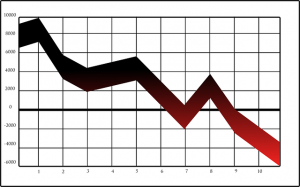
By Richard Morey
April 2023
 January Economic Update
January Economic Update
The biggest economic news is that manufacturing, both here and around the world, continues to contract. The entire manufacturing sector reports less demand, while business spending is pulling in sharply. CEOs are unusually cautious at this time, with many actively cutting their workforce and few increasing their spending.
The prevailing belief right now is that the U.S. government has managed to stave off a banking sector crisis, but we’re now looking at a classic credit crunch. The process of banking sector deposit outflows hasn’t gone down, as nearly $200 billion has fled banks this year and into retail money market funds with higher yields.
It’s now so easy to transfer money out of any bank account that any bank with a whiff of unsound practices remains at risk. The largest risk our public regional banks face involve their massive loans to office building owners in their cities. Many of the loans are likely to quickly bring their regional banks to their knees.
The combination of manufacturing contracting sharply, and CEOs pulling back spending sharply, does not bode well for the broad economy.  This is especially the case when inflation remains a risk, i.e. no Fed to the rescue this time for the economy. By the time they’re able to put down the towels damping down inflation, the contraction will be pervasive and their interest rates reductions won’t attract anyone into leveraging risk.
This is especially the case when inflation remains a risk, i.e. no Fed to the rescue this time for the economy. By the time they’re able to put down the towels damping down inflation, the contraction will be pervasive and their interest rates reductions won’t attract anyone into leveraging risk.
Here are several details related to the economic contraction now underway – in plain view in manufacturing, with glimpses of potential losses to come in recent bank failures:
- A five month string of sub 50 readings in the ISM manufacturing survey is a telltale sign of building recessionary pressures.
- If we combine the production, new orders and employment subindices of each manufacturing survey, we see them falling sharply throughout all of last year – accelerating the decline in the last month.
- We already have a corporate profit recession in process, as they’re down over 12% year-over-year.
- A credit crunch translates into bank lending coming to a halt. Just wait until the office building sector fully re-prices and a group of large regional banks goes under. Non-bank lending is simultaneously contracting due to large asset price losses. Even now, banks are tightening due to the recent failures and coming regulations.
- Without a flow of credit, all of the companies who aren’t creditworthy find they can’t get refinanced and are acquired or go out of business. Solid businesses find funding in private markets – for 15% annual interest (fortunately we’ll own two PIMCO funds making those loans and collecting that interest).
- Back to the present, and adding to recent weakness, were U.S. motor vehicle sales which also missed to the downside in March, faltering 1.1% after the 6.6% drubbing in February — and down in four of the past five months.
Summary
By definition, the services sector remains slightly positive to counteract the losses from manufacturing thus far, as the Atlanta Fed’s GDPNow sits at 1.37% for the first quarter on Tuesday, April 4.
If we are still growing – slightly – this means people are still spending roughly the same amount (though down a touch last month) but have switched from durable goods to eating out and vacations. For now.
Who’s correct, the CEO community all pulling back spending together, or consumers still spending as if everything is going to be all right?  Or is their spending on food and merry today actually caused by them seeing – or at least feeling – the storm already hitting the manufacturing sector – around the world? When you combine it with the flashes of lightening from banks going under in days, you can see why Treasury bonds and gold did so well of late.
Or is their spending on food and merry today actually caused by them seeing – or at least feeling – the storm already hitting the manufacturing sector – around the world? When you combine it with the flashes of lightening from banks going under in days, you can see why Treasury bonds and gold did so well of late.
That is called a classic flight to safety. Should it continue, their recent price gains should greatly accelerate when we go from a “drill” to widespread risk hitting. As that wave continues, only high-quality bonds, managed futures, and quantitative funds with a negative correlation to stocks, and (most likely) gold/silver will benefit. Everything else is looking at what Dr. John Hussman calls a “trap door” right about now.
That’s a market stretched so far beyond any underlying financial facts that the drop can be immediate, and far, the moment the psychological glue holding prices so high ceases to have its grip on investors.
